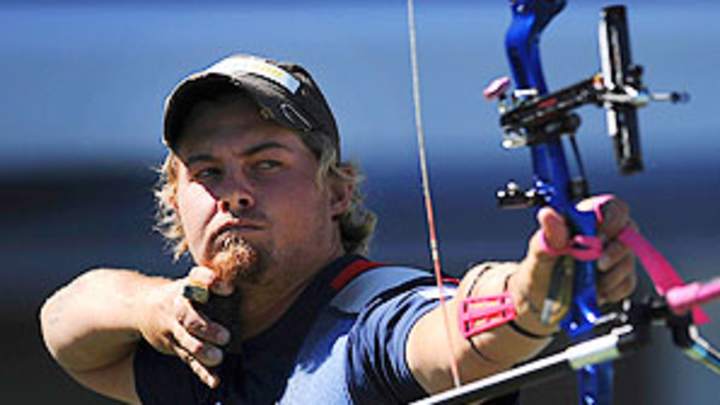Archer Ellison shoots for almost impossible score, Olympic gold


In archery, a score of 1400 in a FITA round is comparable to running a four-minute mile. Many deem it impossible, but the best chase it relentlessly until it is achieved.
In 1998 Australian Clint Freeman became the first archer to break the barrier, shooting a 1409 with a compound bow. However, that bow is more precise and mechanical than the recurve bow used in Olympic archery.
The U.S.'s Brady Ellison, the top-ranked recurve shooter in the world, wants to be the first to shoot a 1400 with a recurve bow. In track terms, Ellison wants to run a four-minute mile in Timberland boots.
"I really don't think 1400 is possible with a recurve bow," said Butch Johnson, a five-time U.S. Olympic archer who trains with Ellison. U.S. archery Olympic coach Kisik Lee, who's been working with Ellison since 2006, also called the milestone an "impossible score," but added, "If he wants to shoot 1400, he has to be smarter and train harder. I believe he can do that."
Ellison's highest score at a FITA event is 1364, 15 points shy of Korean Oh Kyo-Moon's world record, but the American isn't phased. Although he's been shooting bows since he was in diapers (the arrow tips started off as suction cups), Ellison didn't pick up a recurve bow until 2005.
When he was nine years old, Ellison tore up the compound bow circuit, and after making his first World Junior team in 2004, he was invited to a Gold Camp at the Archery Olympic Training Center in Chula Vista, Calif. Since only the recurve bow is used in Olympic archery, Ellison was encouraged to give it a try. However, he learned that it would take him up to five years to start shooting a recurve bow at a level comparable to the one at which he was already shooting a compound.
At first Ellison "thought it was horrible," but that didn't last long. He quickly honed his technique with the new bow, and was the top scoring archer on the 2008 U.S. Olympic team -- which finished fourth overall. He's been the top ranked archer in the world since 2010 and, in 2011 he won an unprecedented 35 of the 37 world ranking events in which he participated.
"I honestly believe that archery is one of my God-given talents," said Ellison. "I always knew I was going to be good, I just didn't know how good."
Individual archery at the Olympic uses a set-scoring system, where archers are given two points for winning a three-arrow set and the first archer to reach six points wins the head-to-head competition. Ellison won't have a chance to break the mythical 1400 barrier in London, but the world's top shooter will be looking for his first Olympic medal. Ellison was shut out of the archery medals in Beijing, but he's the man to beat in 2012.
"We were there, but he wasn't quite ready," Lee said of the 2008 Olympics.
Lee has made major changes to the U.S. Archery infrastructure since taking over as national team coach in 2006. He decided to train all U.S. archers using his world-renowned shooting form, which uses biomechanics to determine the most efficient way to hold a bow steady. That means every U.S. Archery-certified coach is teaching Lee's form.
Ellison believes that Lee's coaching is the reason for his success. ("All of it," he clarifies.) Before learning Lee's form, Ellison relied on the push-pull method to shoot a bow, which relies on the arms, biceps and hands, and is not as consistent, especially when the body gets tired. Lee's form, because it is biomechanically based, uses the entire body and does not fail under pressure, which has allowed Ellison to focus more on the mental aspect of archery. That focus has allowed him to set incredibly high, yet reachable goals -- like winning Olympic gold and shooting a 1400.
"Since I've made that decision mentally to go where no one has gone before, my scores just jumped," said Ellison, who believes part of the reason why a 1400 score has never been reached is because too many archers think it's an impossible milestone.
"Honestly, he's probably the most talented guy I've ever seen in the sport," Johnson said.
Ellison's improvement has had a positive impact on the other U.S. Olympic hopefuls such as Johnson -- who is currently battling for the third and final male archery qualifying spot. Everyone at the Olympic Training Center is improving their scores as they try to keep up with Ellison's ferocious pace.
"He stepped up his performance so much that what was good four or five years ago isn't good anymore," Johnson said. "Brady's the top dog and to beat him you've got to get better."
In other words, Ellison's improvement hasn't just made him the man to beat, but it's also put a target on Team USA's back at the 2012 Olympics, according to Johnson. That's exactly where Ellison wants to be. He said he wants to be the top shooter in the world for the next five to 10 years and is considering picking up compound bow shooting again to earn another world title. His changes in shooting form and mental outlook have him poised to live up to his potential in 2012.
"Mentally I'm just too stubborn to quit so I imagine my body's going to have to quit on me," Ellison said. "I want to be known as the greatest shooter ever."
Ellison has been told that a 1400 FITA round with a recurve bow is impossible, but no one has told him he can't be the greatest ever.
